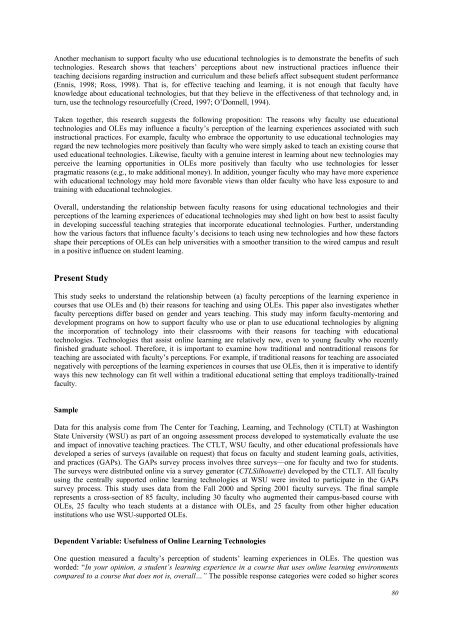Complete issue in PDF - Educational Technology & Society
Complete issue in PDF - Educational Technology & Society
Complete issue in PDF - Educational Technology & Society
Create successful ePaper yourself
Turn your PDF publications into a flip-book with our unique Google optimized e-Paper software.
Another mechanism to support faculty who use educational technologies is to demonstrate the benefits of such<br />
technologies. Research shows that teachers’ perceptions about new <strong>in</strong>structional practices <strong>in</strong>fluence their<br />
teach<strong>in</strong>g decisions regard<strong>in</strong>g <strong>in</strong>struction and curriculum and these beliefs affect subsequent student performance<br />
(Ennis, 1998; Ross, 1998). That is, for effective teach<strong>in</strong>g and learn<strong>in</strong>g, it is not enough that faculty have<br />
knowledge about educational technologies, but that they believe <strong>in</strong> the effectiveness of that technology and, <strong>in</strong><br />
turn, use the technology resourcefully (Creed, 1997; O’Donnell, 1994).<br />
Taken together, this research suggests the follow<strong>in</strong>g proposition: The reasons why faculty use educational<br />
technologies and OLEs may <strong>in</strong>fluence a faculty’s perception of the learn<strong>in</strong>g experiences associated with such<br />
<strong>in</strong>structional practices. For example, faculty who embrace the opportunity to use educational technologies may<br />
regard the new technologies more positively than faculty who were simply asked to teach an exist<strong>in</strong>g course that<br />
used educational technologies. Likewise, faculty with a genu<strong>in</strong>e <strong>in</strong>terest <strong>in</strong> learn<strong>in</strong>g about new technologies may<br />
perceive the learn<strong>in</strong>g opportunities <strong>in</strong> OLEs more positively than faculty who use technologies for lesser<br />
pragmatic reasons (e.g., to make additional money). In addition, younger faculty who may have more experience<br />
with educational technology may hold more favorable views than older faculty who have less exposure to and<br />
tra<strong>in</strong><strong>in</strong>g with educational technologies.<br />
Overall, understand<strong>in</strong>g the relationship between faculty reasons for us<strong>in</strong>g educational technologies and their<br />
perceptions of the learn<strong>in</strong>g experiences of educational technologies may shed light on how best to assist faculty<br />
<strong>in</strong> develop<strong>in</strong>g successful teach<strong>in</strong>g strategies that <strong>in</strong>corporate educational technologies. Further, understand<strong>in</strong>g<br />
how the various factors that <strong>in</strong>fluence faculty’s decisions to teach us<strong>in</strong>g new technologies and how these factors<br />
shape their perceptions of OLEs can help universities with a smoother transition to the wired campus and result<br />
<strong>in</strong> a positive <strong>in</strong>fluence on student learn<strong>in</strong>g.<br />
Present Study<br />
This study seeks to understand the relationship between (a) faculty perceptions of the learn<strong>in</strong>g experience <strong>in</strong><br />
courses that use OLEs and (b) their reasons for teach<strong>in</strong>g and us<strong>in</strong>g OLEs. This paper also <strong>in</strong>vestigates whether<br />
faculty perceptions differ based on gender and years teach<strong>in</strong>g. This study may <strong>in</strong>form faculty-mentor<strong>in</strong>g and<br />
development programs on how to support faculty who use or plan to use educational technologies by align<strong>in</strong>g<br />
the <strong>in</strong>corporation of technology <strong>in</strong>to their classrooms with their reasons for teach<strong>in</strong>g with educational<br />
technologies. Technologies that assist onl<strong>in</strong>e learn<strong>in</strong>g are relatively new, even to young faculty who recently<br />
f<strong>in</strong>ished graduate school. Therefore, it is important to exam<strong>in</strong>e how traditional and nontraditional reasons for<br />
teach<strong>in</strong>g are associated with faculty’s perceptions. For example, if traditional reasons for teach<strong>in</strong>g are associated<br />
negatively with perceptions of the learn<strong>in</strong>g experiences <strong>in</strong> courses that use OLEs, then it is imperative to identify<br />
ways this new technology can fit well with<strong>in</strong> a traditional educational sett<strong>in</strong>g that employs traditionally-tra<strong>in</strong>ed<br />
faculty.<br />
Sample<br />
Data for this analysis come from The Center for Teach<strong>in</strong>g, Learn<strong>in</strong>g, and <strong>Technology</strong> (CTLT) at Wash<strong>in</strong>gton<br />
State University (WSU) as part of an ongo<strong>in</strong>g assessment process developed to systematically evaluate the use<br />
and impact of <strong>in</strong>novative teach<strong>in</strong>g practices. The CTLT, WSU faculty, and other educational professionals have<br />
developed a series of surveys (available on request) that focus on faculty and student learn<strong>in</strong>g goals, activities,<br />
and practices (GAPs). The GAPs survey process <strong>in</strong>volves three surveys—one for faculty and two for students.<br />
The surveys were distributed onl<strong>in</strong>e via a survey generator (CTLSilhouette) developed by the CTLT. All faculty<br />
us<strong>in</strong>g the centrally supported onl<strong>in</strong>e learn<strong>in</strong>g technologies at WSU were <strong>in</strong>vited to participate <strong>in</strong> the GAPs<br />
survey process. This study uses data from the Fall 2000 and Spr<strong>in</strong>g 2001 faculty surveys. The f<strong>in</strong>al sample<br />
represents a cross-section of 85 faculty, <strong>in</strong>clud<strong>in</strong>g 30 faculty who augmented their campus-based course with<br />
OLEs, 25 faculty who teach students at a distance with OLEs, and 25 faculty from other higher education<br />
<strong>in</strong>stitutions who use WSU-supported OLEs.<br />
Dependent Variable: Usefulness of Onl<strong>in</strong>e Learn<strong>in</strong>g Technologies<br />
One question measured a faculty’s perception of students’ learn<strong>in</strong>g experiences <strong>in</strong> OLEs. The question was<br />
worded: “In your op<strong>in</strong>ion, a student’s learn<strong>in</strong>g experience <strong>in</strong> a course that uses onl<strong>in</strong>e learn<strong>in</strong>g environments<br />
compared to a course that does not is, overall…” The possible response categories were coded so higher scores<br />
80
















